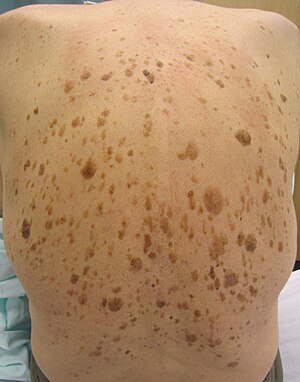Seborrheic keratosis
| Seborrheic keratosis | |
|---|---|
 |
|
| Multiple seborrheic keratoses on the dorsum of a patient with Leser–Trélat sign. | |
| Classification and external resources | |
| Specialty | Dermatology |
| ICD-10 | L82 |
| ICD-9-CM | 702.1 |
| OMIM | 182000 |
| DiseasesDB | 29386 |
| MedlinePlus | 000884 |
| eMedicine | derm/397 |
| MeSH | D017492 |
A seborrheic keratosis, also known as seborrheic verruca or a senile wart, is a non-cancerous (benign) skin tumor that originates from cells in the outer layer of the skin (keratinocytes). Like liver spots, seborrheic keratoses are seen more often as people age.
The tumors (also called lesions) appear in various colors, from light tan to black. They are round or oval, feel flat or slightly elevated, like the scab from a healing wound, and range in size from very small to more than 2.5 centimetres (1 in) across. They can often come in association with other skin conditions, including basal cell carcinoma. Sometimes seborrheic keratosis and basal cell carcinoma occur at the same location, and sometimes seborrheic keratosis progresses to basal cell carcinoma. At clinical examination the differential diagnosis include warts and melanoma. Because only the top layers of the epidermis are involved, seborrheic keratoses are often described as having a "pasted on" appearance. Some dermatologists refer to seborrheic keratoses as "seborrheic warts", because they resemble warts, but strictly speaking the term "warts" refers to lesions that are caused by human papillomavirus.
Seborrheic keratoses may be divided into the following types:
Also see:
The cause of seborrheic keratosis is not known.
Visual diagnosis is made by the "stuck on" appearance, horny pearls or cysts embedded in the structure. Darkly pigmented lesions can be challenging to distinguish from nodular melanomas. Furthermore, thin seborrheic keratoses on facial skin can be very difficult to differentiate from lentigo maligna even with dermatoscopy. Clinically, epidermal nevi are similar to seborrheic keratoses in appearance. Epidermal nevi are usually present at or near birth. Condylomas and warts can clinically resemble seborrheic keratoses, and dermatoscopy can be helpful. On the penis and genital skin, condylomas and seborrheic keratoses can be difficult to differentiate, even on biopsy.
...
Wikipedia
